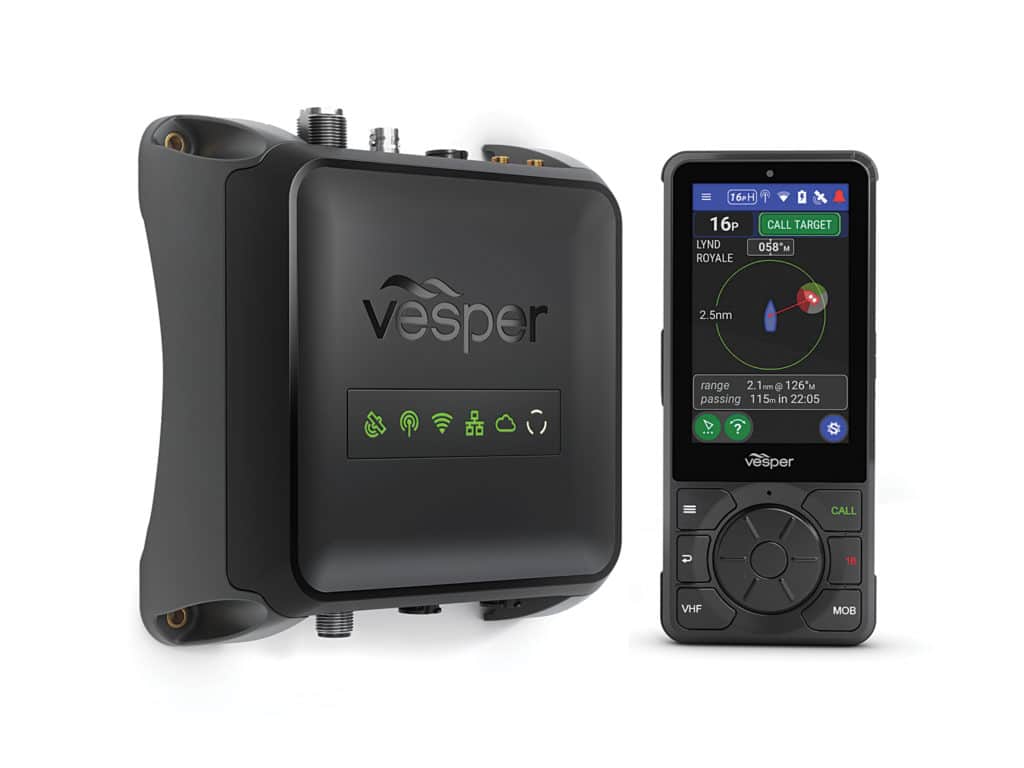
While VHF radios have long served mariners, many sailors aren’t fully utilizing all the capabilities of modern VHF units with Digital Selective Calling. As a result, many VHFs show wear on only two controls: power and volume. Vesper Marine’s revolutionary new Cortex safety and communications platform dramatically simplifies VHF operations, and delivers Automatic Identification System, cellular, DSC and Wi-Fi communications to a dedicated handset or smartphone app. Even better, Cortex provides smart alarms with “situation views” that prioritize concerns.
Hardware-wise, Cortex is comprised of an IPX7-rated (waterproof) black-box M1 processor and one or more optional- but-recommended H1 handsets, plus two smartphone apps (Cortex Onboard and Cortex Monitor). The M1, which is mounted to a belowdecks bulkhead, features a built-in AIS B/SO transponder, an embedded SIM card, an integrated VHF splitter, a nine-axis sensor, bilge-pump-sensor input, NMEA 0183/2000 connectivity, dual audio ports, a battery-voltage sensor, and two remotely commanded control outputs.
Aesthetically, H1 handsets loosely resemble later-generation Apple iPods, with generous-size optically bonded Gorilla Glass touchscreens and six hard buttons (menu, back, VHF, call, Channel 16 and MOB) that flank a rotary wheel with a central selector. A dedicated DSC emergency button sits under a protective hood. The handsets are IPX7-rated, support one-handed operations, and feature a rubberized treatment that absorbs impacts and is easy to grip.
Once installed, Cortex wirelessly shares all communications with its paired H1 handsets (the Cortex Onboard app delivers all of an H1’s capabilities except for VHF operations), which render this information as intuitive graphical depictions. Users choose between “VHF,” “directory” (stored DSC contacts), “instruments” (NMEA data), and “plotter” operating modes, and the system includes three prioritized situation views for managing AIS targets, anchor-watch alarms and crew-overboard emergencies. “Alarm management always runs in the background,” says Jeff Robbins, Vesper’s CEO. “If an alarm comes in and a user acknowledges it, Cortex directs them to the source. But if another [alarm] becomes more important, the system prioritizes this [threat].”
Cortex handsets and the Cortex Onboard app allow users to call other AIS-equipped boats by just tapping their on-screen icons. Likewise, users can easily hail their stored DSC contacts. “We tried to hide as many [DSC and VHF] knobs and settings as possible,” Robbins explains.
The company took a similar approach to updates. “We designed Cortex from the start to be easily upgradable, and all software is upgraded automatically from a user’s paired mobile device,” Robbins says.
While Vesper Marine has long employed smart-alarm logic to prioritize AIS targets and provide anchor-drag and MOB alarms, its earlier-generation smartAIS features were limited to onboard use. Now, thanks to Cortex’s cloud-monitoring service, users can access these alarms, and view their real-time anchor watch, geofence, shore power, battery levels, high-water, motion and temperature data via their smartphone. Cortex works without a subscription, however users are restricted to twice-a-day updates.
Users can access onboard alarms using their app or the handset, and they can network their M1s to external speakers, allowing Cortex to deliver audio alerts.
Much like the introduction of the first-generation iPhone, Cortex promises to be a juggernaut, starting with its dramatically decluttered and user-friendly approach to VHF and DSC, as well as its AIS, monitoring and smart-alarming capabilities. And, thanks to the platform’s software-based approach, new features and capabilities will be developed and released in real time, ensuring that Cortex-equipped mariners always cruise with the latest and safest features.








